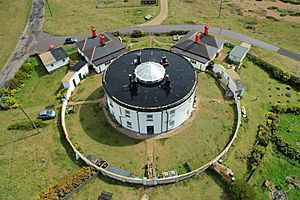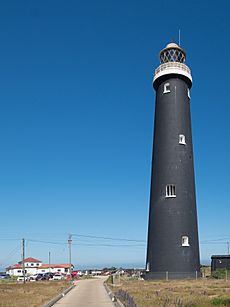Dungeness Lighthouse facts for kids
| Location | Dungeness Kent England |
|---|---|
| Coordinates | 50°54′48.5″N 0°58′33.6″E / 50.913472°N 0.976000°E |
| Year first constructed | 1615 (first) 1635 (second) 1792 (third) 1904 (fourth) |
| Year first lit | 1961 (current) |
| Automated | 1991 |
| Construction | concrete tower |
| Tower shape | cylindrical tower flared at the top with balcony and lantern |
| Markings / pattern | tower with black and white bands, white lantern |
| Height | 43 m (141 ft) |
| Focal height | 40 m (130 ft) |
| Original lens | 4th order catadioptric four panel rotating |
| Intensity | 134,000 Candela |
| Range | 21 nmi (39 km) |
| Characteristic | Fl W 10s. |
| Fog signal | 1 blast every 30s. |
The Dungeness Lighthouse is a famous landmark on the Dungeness Headland in Kent, England. It started guiding ships on November 20, 1961. This lighthouse was built because the new Dungeness nuclear power station blocked the light from the older lighthouse (built in 1904). Even though the old lighthouse is no longer used, it still stands nearby.
The current lighthouse is the fifth one built on this spot. It is made from strong, precast concrete rings. Its cool black and white stripes are part of the concrete itself. This lighthouse is still active today. It is watched and controlled from the Trinity House Operations and Planning Centre in Harwich, Essex.
Contents
History of Dungeness Lighthouses
There have been many lighthouses at Dungeness over the years. In total, eight different lights have helped guide ships. Five of these were main lighthouses, and three were smaller, helper lights. A helper light became needed because the land at Dungeness keeps growing outwards into the sea. This means the lighthouses slowly get further away from the water.
In the 1800s and 1900s, Dungeness was a testing ground for Trinity House, the group that manages lighthouses in England. It was one of the first lighthouses to get a fog horn in the 1860s. It also had one of the first electric lamps, though that didn't last long at first.
The Very First Lights
At first, sailors were warned by a simple beacon, which was like a big fire. This was replaced by a proper lighthouse in 1615. As the sea moved further away, a new lighthouse was built closer to the water in 1635. It was known as Lamplough's Tower.
Wyatt's Tower: The 1792 Lighthouse
As more shingle (small stones) built up, a newer lighthouse was constructed in 1792. It was built by Samuel Wyatt for Thomas William Coke. This lighthouse was about 35 m (115 ft) tall. It used 18 Argand lamps and special mirrors to shine its light.
In 1837, Trinity House bought the rights to manage the lighthouse. A few years later, in 1843, they built homes for the lighthouse keepers around the base of the tower. The tower was painted red to make it easier to see during the day. From 1865, it had alternating red and white stripes. Later, red lights were added to show safe places for ships to drop anchor.
Early Electric Light Experiments
In the early 1860s, Dungeness was chosen for an important experiment. Michael Faraday, a famous scientist, decided it would be the first lighthouse to have a permanent electric light. Two electric lamps were installed, with oil lamps kept as a backup. The new electric light started working on February 1, 1862.
However, the electric light had problems. The engines often broke down, and the bright sparks from the lamp damaged the lenses. Because of these issues, the electric light was eventually replaced. Lessons learned from Dungeness helped make electric lights much better for other lighthouses later on.
One big problem with the electric light at Dungeness was that the tower was not very tall. The intense light could blind sailors, especially when they were close to shore. As the land grew, this problem got worse. So, on October 1, 1875, the lighthouse went back to using a powerful oil lamp.
Demolition of Wyatt's Tower
By the end of the 1800s, the sea had moved even further away. So, a decision was made to build a brand new main lighthouse. Once the new light was ready, Wyatt's tower was taken down in 1904. However, the circular homes for the lighthouse keepers still stand today.
Early Fog Signals and Helper Lights
In 1862, an inventor named Celadon Daboll showed off his new Daboll trumpet (an early reed fog horn) at Dungeness. It was a success, and this fog horn was bought and used at Dungeness. It sounded every 20 seconds from a small wooden building near the shore.
In 1865, an improved Daboll trumpet was installed. This was the first time Trinity House had put a fog horn at one of its lighthouses. This new trumpet could turn to sound in four different directions.
In 1875, a new type of fog signal, an early siren, was installed. It was in a new building close to the sea and sounded one blast every minute.
The First Low Light
At the same time, a new "Low Lighthouse" was built next to the fog signal house. This was a short metal tower with a light that helped the main lighthouse, which was now far from the shore. It was about 225 yards (206 m) from the main lighthouse. This helper light used oil and flashed white every five seconds. It started working on October 1, 1875, the same day the main lighthouse switched back to oil.
In 1877, the fog signal changed to two blasts every two minutes. In 1881, it was changed again to make a two-tone sound (a high note followed by a low note) every two minutes.
The Fourth Lighthouse (The 'Old' Lighthouse)
Building of the fourth main lighthouse began in 1901. It was meant to be built closer to the sea, but there were problems with the ground. So, it ended up being built only 40 yards (37 m) from the previous one. The Prince of Wales (who later became George V) opened it, and its light first shone on March 31, 1904.
This new tower had a special Fresnel lens that spun around, making a flash every ten seconds. It also had red and green lights lower down to show dangers and safe areas for ships. It was lit by oil and was one of the most powerful lights in the English Channel.
This tower still stands today. It is no longer used as a lighthouse but is open for visitors. It is a round brick building, 41 m (135 ft) tall. It has 169 steps, and from the top, you can get a great view of the shingle beach. The original lamp, lenses, and clockwork motor are still inside. It is a Grade II listed building, which means it's an important historic building.
Gallery
Later Fog Signals and Low Lights
The Second Low Light
In 1904, when the main lighthouse was rebuilt, a new Low Lighthouse and fog signal house were also built. They were 345 yards (315 m) east of their old spot. The new Low Light was a round metal tower, 40 ft (12 m) tall, and painted red. The fog signal house had new siren equipment with two horn-shaped trumpets on the roof. Both the light and fog signal kept their same patterns as before. They started working on the same day as the new main lighthouse.
The Third Low Light
In 1931-32, another new fog signal house was built. It had a new Low Lighthouse on its roof. This tower included two new diaphone fog horns. The Low Light continued to flash every five seconds. It was 45 ft (14 m) high and could be seen from 11 nmi (20 km; 13 mi) away. The diaphone sounded three blasts every two minutes.
In July 1958, more tests were done at Dungeness for fog signals. They compared the diaphone, siren, and a new electric signal. A version of this electric signal was later used in the design of the current Dungeness Lighthouse.
The Low Lighthouse and diaphone fog signal were used until 1959. They were then removed to make space for the current lighthouse, which was built exactly where they had stood.
The Fifth (Current) Lighthouse
As the sea continued to move further away, and after the nuclear power station was built (which blocked the light of the 1904 lighthouse), the fifth lighthouse, the current Dungeness Lighthouse, was constructed. It was the first major new lighthouse built in Britain in 50 years and started working in 1961.
It was first equipped with a special flashing xenon arc lamp. However, this new technology didn't work well for guiding ships. So, it was soon replaced with a group of sealed beam lights. These were later replaced in 2000 with a smaller, spinning Fourth order Fresnel lens from another lighthouse. Besides the main light, there are also sector lights that shine from windows just below the top. Since 1962, the tower has been lit up at night. This helps people see it and also helps protect migrating birds, which used to hit the tower in the dark.
In 1954-56, tests were done at Dungeness for a new electric fog signal. It used speakers built into a curved stack of concrete blocks. This experiment was successful, and similar speaker stacks were later installed at about a dozen other lighthouse stations. At Dungeness, a stack of 60 such speakers was built right into the lighthouse tower. These were used until 2000, when they were replaced by an electronic signal at the base of the tower. It used to sound three blasts every minute, but this was changed in 2022 to one blast every 30 seconds.
Since 2003, Dungeness Lighthouse has been a Grade II* listed building. This means it is a very important historic building.
See also
- List of lighthouses in England
- Grade II* listed buildings in Folkestone and Hythe









